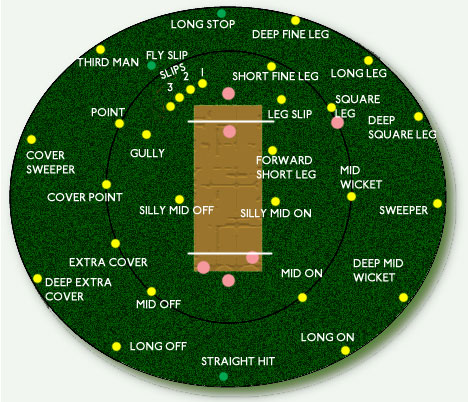Cricket – Ground

The ground has no set dimensions. It may be circular or oval and must be limited to a maximum of 75 yards (69 meters) in any direction from its center.
Boundaries may be marked by a line or a fence. The main action takes place in the middle of the ground on a pitch, a strip 66 feet (20 meters) long and 10 feet (30 meters) wide.
Centered at either end of the pitch is a 9-inch- ((23-cm-) wide wicket composed of three thin 28-inch- (71-cm-) long poles, or stumps, placed upright in the ground and of sufficient size to prevent the ball from passing between them.
On top of the stumps are two 43/8-inch (11-cm) crosspieces, or bails, balanced in grooves in the stumps. A dislodged bail retires the batsman. There are three limiting markings at each wicket. The bowling crease is in line with the stumps and is 8 feet 8 inches (22 cm) long.
The return crease is formed by 4-foot (1 meter) arms at right angles to the bowling crease, two extending away from and two toward the opposite wicket. The popping crease is a 12-foot (3.5 meter) line parallel with and 4 feet in front of each bowling crease; this line designates the extent of the batsman’s safe ground. In bowling, the bowler’s front foot must not land beyond the popping crease and his back foot must remain completely within the return crease or its forward extension.
The ground is divided lengthwise into offside and leg or on-side. As the batsman takes his stand at the wicket the off-side is the ground to the right of a line drawn to the bowler’s end opposite him. The leg or on-side is the ground to the left.
Cricket Equipment

The bat has a willow striking face, which must not be more than 38 inches long, and a cane handle layered with thin strips of rubber bound with twine or steel spring and covered with a sheath of rubber.
The bat may not be wider than 41/4 inches and usually weighs between 4 and 6 ounces over 2 pounds.
The ball has a hand-stitched red leather cover and an interior of cork wound with twine. It weighs between 51/2 and 53/4 ounces and measures 9 inches in circumference.
A cricketer’s uniform is white: shirt, trousers, boots, and sweater. Batsmen and the wicketkeeper also wear gloves and pads to protect their hands and legs and a helmet with a mesh face guard. The umpires wear long white coats over normal clothing.